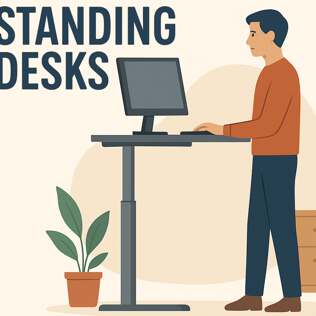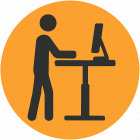Adjustable Standing Desks Explained: Electric, Manual, and Hybrid
People buy adjustable standing desks for many reasons: better posture, more movement during the day, or to stop the afternoon slump. Choosing between electric, manual, and hybrid models comes down to how often you change height, how much gear you put on your desk, and how much you want to spend. Here’s a clear, human friendly guide to help you decide.
Electric standing desks
These are the push button models most offices use. Powerful motors lift heavier loads smoothly, so multiple monitors, docking stations, and desk plants are no problem. Speed and convenience are the headline benefits: one touch, your workstation moves to the exact height you saved. Expect quieter operation and greater precision. Drawbacks include higher cost, slightly more complex assembly, and the need for a nearby power supply. If you toggle between sitting and standing many times daily, this is usually the best fit.
Manual standing desks
Manual desks come in two main flavors: the hand crank and the counterbalance or gas assisted style. Hand crank desks are mechanically simple, very affordable, and reliable; they do require effort to change height, so they suit users who rarely adjust. Counterbalance designs use springs or gas pistons to make lifting almost effortless; they feel lighter and are often cheaper than electric desks. Manual options shine when budget, portability, or a low tech aesthetic matter.
Hybrid standing desks
A hybrid blends the best of both worlds: an electric motor with a manual override, or a motorized frame paired with lighter electronics to cut cost. Hybrids can be useful when you want electric convenience most of the time but need a fail safe for power outages, or when weight capacity is moderate and you want a lower price point. They tend to be practical choices for home offices that have varied needs.
Key factors to consider
- Frequency of adjustments: frequent equals electric.
- Load and stability: more monitors favor electric or heavy duty hybrids.
- Budget: manual for tight budgets; electric if you can invest.
- Noise and speed: motors vary; read reviews for decibel levels and lift speed.
- Warranty and service: motors and electronics can fail; longer warranties matter.
A short checklist for buying: test the lift range (make sure it fits your standing height), check stability at full extension, confirm weight capacity, and look for useful extras like memory presets, cable management, and anti- collision sensors.
If you want a quick rule: get electric for daily, frictionless adjustments; pick manual for simple, economical solutions; choose hybrid when you want a compromise between cost and convenience. The right desk supports your body and your flow, not just your monitors. Pick one that encourages more movement and fewer compromises. #standingdesk #sitstand #ergonomics

